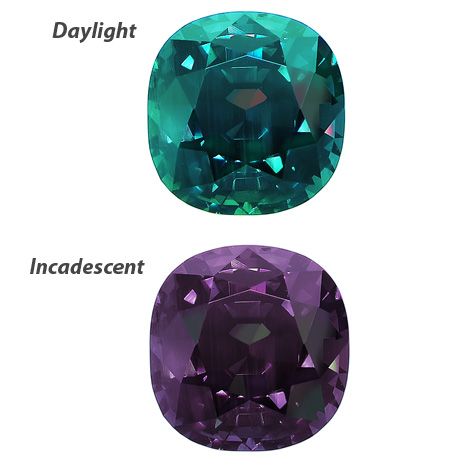The Gemstone Alexandrite

Alexandrite is the highly regarded color changing variety of Chrysoberyl. The color of Alexandrite changes under different lighting conditions. If viewed in daylight, its color is
greenish blue to
dark yellow-green. If viewed in incandescent or candle light, its
color is pink to red. Alexandrite is a very rare and highly valuable gemstone, and until recently was extremely difficult to obtain due to its rarity. However, new sources in Brazil and Tanzania have made this gemstone available and more mainstream on the gemstone market.
Color
?
Blue, Red, Green, Yellow, Pink, Purple, Gray, Multicolored
Chemical Formula
?
BeAl
2O
4
Mineral Class
?
Chrysoberyl
All About
Alexandrite was first discovered in Russia in the early 1800's. It was named in honor of Alexandar Nicholavich, who was later to become the Russian
Czar Alexander II. Legend has it that the gemstone was discovered on the future Czar's birthday and named in his honor, though the factual nature of this is disputed.
The unique color change habit of Alexandrite is caused by slight
impurities of the
element chromium. The most desirable colors of
Alexandrite are those that show a clearly visible pure hue color change, such as a pure green/blue in daylight to a pure
red in incandescent light.
In addition to its color-changing habit, Alexandrite is a
pleochroic gem, showing different color intensity
when viewed at different angles. This factor must be taken into account
when cutting Alexandrite gemstones. Alexandrite exhibiting
chatoyancy does exist but is very rare, thus Alexandrite
Cat's
eye is rarely available.
Uses
?
Alexandrite is a rare and exquisite gemstone with outstanding color changing properties, and is most often faceted into round and cushion cuts that can bring out the best in its color. In jewelry, Alexandrite is used as rings and
pendant centerpieces. Alexandrite in large sizes is extremely rare and valuable; most Alexandrite available is 2
carats or less.
False Names
?
Alexandrine - Synthetic, lab grown Alexandrite simulant.
Alexandrite Sapphire - Synonym of
Color-change Sapphire.
Alexandrite Garnet - Synonym of
Color-change Garnet.
Blue Alexandrite - Synonym of
Color-change Sapphire.
Czochralski Alexandrite - Synthetic, lab grown Alexandrite simulant.
Treatments & Enhancements
?
Alexandrite gemstones are not treated or enhanced. A synthetic form of Alexandrite exists, and it can be difficult to distinguish natural and synthetic Alexandrite from each other. Most synthetic Alexandrite is in fact synthetic
Corundum or synthetic
Spinel with added vanadium or chromium to induce the color-change habit.
Alexandrite Sources
?
Alexandrite was originally discovered in the Sanarka River in the southern Ural Mountains of Russia. However, the Russian deposits have long since been exhausted, and Russian sources of Alexandrite are near impossible to obtain. Small deposits were subsequently found in Sri Lanka (Ceylon), and until the 1980's these were the only two sources of this rare gemstone. Since then, new deposits have been discovered in Brazil, Tanzania, and Madagascar, with the Brazilian sources being the most significant.
Similar Gemstones
?
The only other color changing gemstones are
Color-change Garnet and
Color-change Sapphire. Alexandrite is softer than Sapphire and harder then Garnet.
Alexandrite in the Rough Photos
?